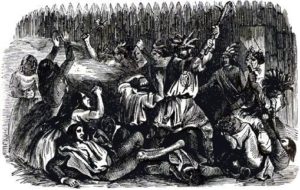Slave Revolt at Fort Mims
excerpted and condensed from
David Tate: Origins
by
Illustration 1: Attack at Fort Mims. Courtesy the New York Library, Digital Collections.
There were 740 slaves in the 1810 Baldwin County, Mississippi Territorial Census, give or take 20 persons. Free white people numbered 667.
Prior to the uprising of Red Stick warriors against the oppression of Benjamin Hawkins’ “civilization plan,” David Tate alerted the Mississippi Militia of the immediate danger of Indian war. The settlers of Tombigbee and Tensaw regions set about furiously amassing arms and provisions at the home of Samuel Mims. Because of its central location (above the “cut-off”), most inhabitants fled to Mims’ farm, including Tate’s wife and in-laws, the John Randon family.
The majority of slaves were treated no differently than the herds of hogs, horses, and cattle; they were left outside the fort, to manage on their own against an impending attack by hostile Indians. This was done with full knowledge that the Indians spared nothing in their destruction of property. A few young slaves were permitted within the fort as personal servants to provide the daily menial tasks. Of these, two boys were subjected to the vilest treatment accorded black slaves; they were tied to a post and whipped mercilously and unjustly for truthfully reporting the incursion of hostiles in the vicinity of the fort. Beasley had made an attempt to verify their reports, but when unproven, unleashed his fury against the children.
Unfortunately for the inmates of Fort Mims, the commanding officer, Daniel Beasley, was reportedly daily absent the use of his faculties. Beasley incompetently failed to properly complete the blockhouses needed to fortify the ground; both the main (east) and west gates to the fort were wide open on the day of the attack (according to drawings by Caleb Swan). Undoubtedly, Beasley was oblivious to his evisceration.
Numerous mnemonic versions of what happened at Fort Mims on August 30, 1813, occur in the record, and purport to be historical. For instance, “McGillivray’s negroes,” were reported to have been the source of the fired arrows that ignited the kitchen and other structures in the second phase of the attack, inciting the Red Sticks to further violence against the settlers. I found this to obviously be a fabrication for the following reasons: 1) Chief Alexander McGillivray was dead for twenty years; he no longer owned anybody; 2) all “negroes,” spoke Muscogee; thus, they were at least second-generation Creek; and more than likely indistinguishable from the settlers and other Indians. Finally, since they outnumbered the settlers/owners, there existed the hallmarks of a slave revolt. If it looks like a duck, it’s a duck.
Using strictly empirical evidence and records, I have compiled what follows. The census records for the Mississippi, State and Territorial Census Collection, 1792-1866, according to Willis Brewer.1 There were a total of 2,624 blacks in the three counties of Madison, Washington, and Baldwin. 2 Another enumeration in 1816 was conducted, prior to the creation of the State of Alabama.
Baldwin County
Mississippi Territory
1810 1816 1820
Blacks 740-760 676 (approxi. 100 souls) However, see below…
©2016 All Rights Reserved.
1Willis Brewer, Alabama, her history, resources, war record, and public men : from 1540 to 1872, Montgomery, Ala.: Barrett & Brown, 1872, 714 pgs. . Page 115. At HeritageQuest.com, PERSI online, clevnet.org.http://persi.heritagequestonline.com.ezproxy.cpl.org/hqoweb/library/do/books/results/image?urn=urn%3Aproquest%3AUS%3Bglhbooks%3BGenealogy-glh36348218%3B-1%3B-1%3B&polarity=&scale=&jumptophysicalpage=115
2William G. Brown,, a History of Alabama for use in Schools based as to its earlier parts on the work of Albert J. Pickett, Published 1900 by University publishing company in New York, New Orleans. pg. 99, found at : openlibrary.org.


